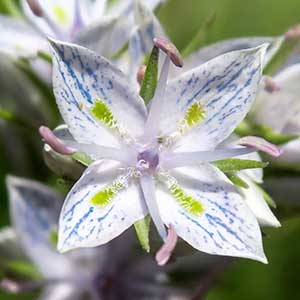Frasera albicaulis
Frasera montana
white-stem elkweed, white-stem frasera
white frasera
1–few, with several rosettes.
1–several, with several rosettes.
blades narrowly white-margined;
basal oblanceolate, 4–23 × 0.3–1.2(–2) cm, basal leaves generally longer than lowest internode;
cauline leaves opposite, proximal blades oblanceolate to oblong, distal linear-oblong.
blades white-margined;
basal narrowly spatulate-oblanceolate to lanceolate, 7–30 × 0.5–1.5 cm;
cauline leaves opposite, blades narrowly lanceolate to linear.
narrow, 1.5–4(–5) cm wide, interrupted proximally, ± continuous distally.
narrow, 1.5–4 cm wide, dense.
calyx 3–7(–12) mm;
corolla greenish white to pale or medium blue, usually dark blue- to purple-dotted and/or with a dark blue, purple, or green central stripe (except in var. idahoensis), 6–12 mm, lobes oblong-obovate-elliptic, widest near midlength, abruptly tapering to acute to short-acuminate apex;
androecial corona scales present, variable among the varieties;
style slender, distinct;
nectaries and foveae 1 per corolla lobe, foveae distal to nectary, opening into an elliptic-oblong to lance-ovate differentiated area on the corolla surface, rim fringed all around but with fringes shorter distally, or not fringed toward distal end.
calyx 3–6(–8) mm;
corolla white to cream, unmarked, 5–9 mm, lobes elliptic-ovate, apex rounded, apiculate;
androecial corona scales obovate-oblong, 1–2 mm, margins nearly entire to deeply lacerate or fringelike;
style slender, distinct;
nectaries and foveae 1 per lobe, foveae opening into an elliptic-obovate to suborbiculate differentiated area on the corolla surface, rim ± evenly fringed all around.
Frasera albicaulis
Frasera montana
Varieties 5 (5 in the flora).
Frasera albicaulis varies in vegetative and abaxial corolla puberulence and in the size and dissection of the androecial corona. It has sometimes been divided into several species and additional varieties, but, from the material available for study at the time of this writing, it appears appropriate to recognize only five varieties, although F. ackermaniae might be considered for inclusion at varietal rank. Each of these varieties has a more or less distinct geographic range, but some intergrade.
(Discussion copyrighted by Flora of North America; reprinted with permission.)
Frasera montana is endemic to the mountains of western Idaho.
Frasera montana appears to be closely related to F. albicaulis and might be treated as another variety of that species, but its proportionately wide corolla lobes with rounded rather than acute to acuminate apices, reminiscent of the petals of apple blossoms, give the flowers of this attractive species a distinctive appearance. The differentiated areas on the corolla surface into which the foveae open are elliptic to nearly round and are proportionately shorter than those of any variety of F. albicaulis. Frasera montana might most readily be confused with F. albicaulis var. idahoensis, which likewise usually has unspotted corollas, but it can be distinguished not only by the shape of its corolla lobes but also by the differentiated areas on its corolla lobes with rims that are more or less evenly long-fringed all around; those of all varieties of F. albicaulis are distally more shallowly or not fringed. The androecial corona scales of both species are variable, but those of F. montana are generally cleft more or less longitudinally, if at all, whereas those of F. albicaulis var. idahoensis (but not all varieties of F. albicaulis) usually bear lateral as well as terminal lobes or fringes.
(Discussion copyrighted by Flora of North America; reprinted with permission.)
1. Stems and abaxial or both leaf surfaces puberulent; rim of differentiated area on corolla surface not fringed at distal end. | → 2 |
2. Corona scales oblong, margins lacerate or deeply toothed, ultimate divisions threadlike. | var. albicaulis |
2. Corona scales ovate to obovate or oblanceolate, margins entire or shallowly 2–3-lobed, rarely absent. | var. modocensis |
1. Stems glabrous; leaf blades glabrous or puberulent only near base and abaxially along midvein; rim of differentiated area on corolla surface fringed all around, fringes shorter near distal end. | → 3 |
3. Corona scales ovate to elliptic, margins entire or shallowly undulate-erose or toothed. | var. cusickii |
3. Corona scales ovate to elliptic to oblong-lanceolate, margins lacerate or deeply lobed. | → 4 |
4. Corollas greenish white or pale to medium blue, generally with dark blue to purple spots; corona scales 1–4 mm, oblong-lanceolate. | var. nitida |
4. Corollas pale blue, usually without darker spots; corona scales 2–6 mm, widely ovate to elliptic. | var. idahoensis |


